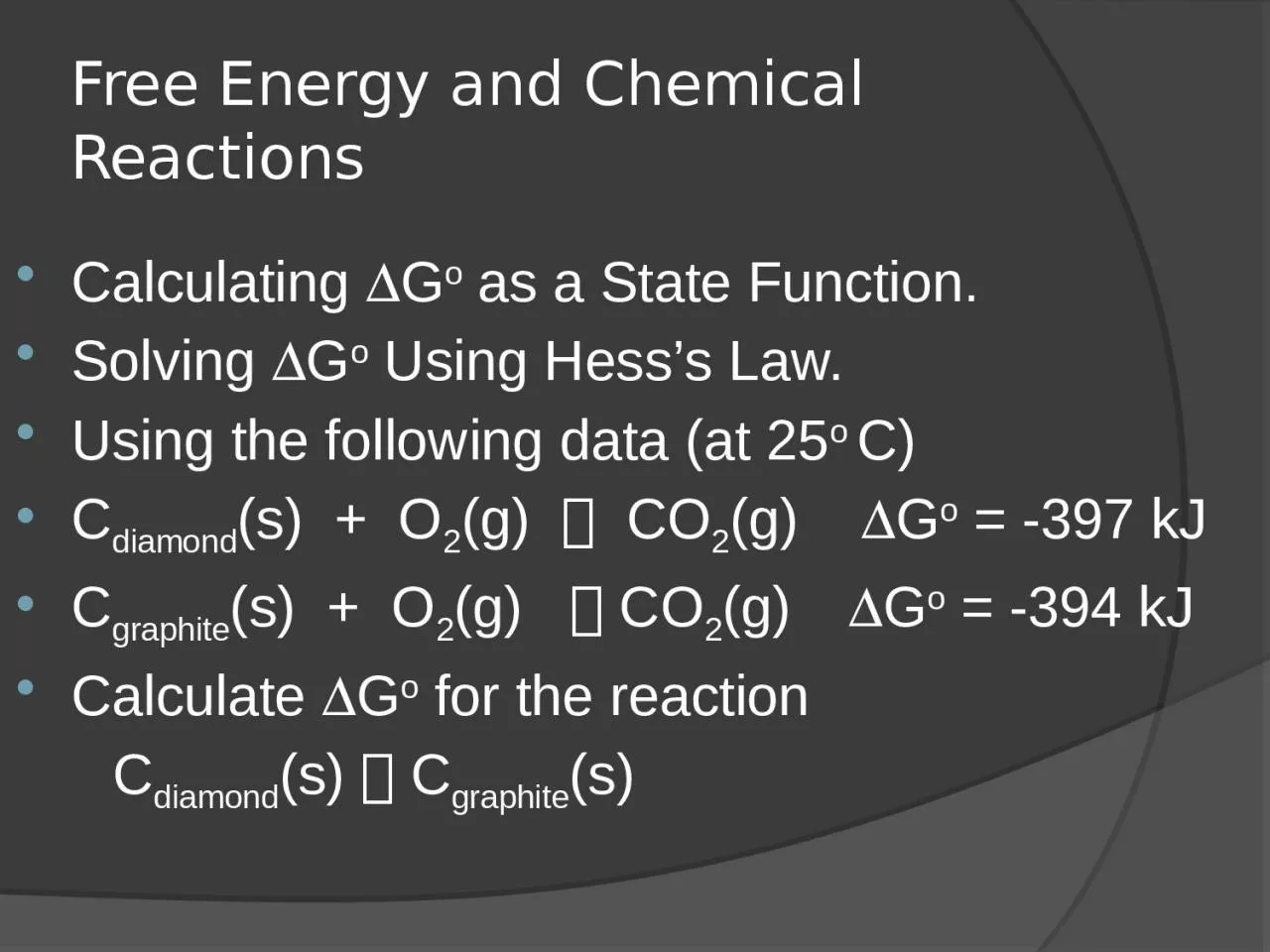

Calculating D G o as a State Function Solving D G o Using Hesss Law Using the following data at 25 o C C diamond s O 2 g CO 2 g D G ID: 930618
Download Presentation The PPT/PDF document "Free Energy and Chemical Reactions" is the property of its rightful owner. Permission is granted to download and print the materials on this web site for personal, non-commercial use only, and to display it on your personal computer provided you do not modify the materials and that you retain all copyright notices contained in the materials. By downloading content from our website, you accept the terms of this agreement.
Slide1
Free Energy and Chemical Reactions
Calculating
D
G
o
as a State
Function.
Solving
D
G
o
Using Hess’s
Law.
Using
the following data (at
25
o
C)
C
diamond
(s
) + O
2
(g)
CO
2
(g)
D
G
o
= -397
kJ
C
graphite
(s
) + O
2
(g)
CO
2
(g)
D
G
o
= -394
kJ
Calculate
D
G
o
for the reaction
C
diamond
(s)
C
graphite
(s)
Slide2Free Energy and Chemical Reactions
Calculating
D
Go as a State Function.Standard Free Energy of Formation (DGfo).DGo = SnpDGfo products - SnrDGfo reactantsMethanol is a high-octane fuel used in high-performance racing engines. Calculate DGo for the reaction2CH3OH(g) + 3O2(g) 2CO2(g) + 4H2O(g)
Slide3Free Energy and Chemical Reactions
A
chemical engineer wants to determine the feasibility of making ethanol (C
2H5OH) by reacting water with the ethylene (C2H4) according to the equation C2H4(g) + H2O(l) C2H5OH(l) Is the reaction spontaneous under standard conditions?
Slide4The Dependence of Free Energy on Pressure
The equilibrium position represents the lowest free energy value available to a particular
reaction.
Free energy changes throughout the course of a reaction because it is pressure and concentration dependent.For any 1 mole of a gas at a given temperatureS large V > S small V or S low P > S high P
Slide5Free Energy and Equilibrium
For
standard conditions at
equilibriumDGo = -RT ln(K)This is on the equations sheetDGo is the free energy at standard conditions, T is the Kelvin temperature, R is the ideal gas constant 8.31 J/mol K, and K is an equilibrium constant ( like we found in the previous unitNote- R gives you a value in J, not kJ
Slide6Equilibrium and Free Energy
The reaction for the synthesis of ammonia is:
N
2 + 3 H2 2 NH3Calculate the equilibrium constant for this reaction at 25oC.Hfo (kJ/mol)So (J/mol)N20192H20131NH3-46193
Slide7Free Energy and Equilibrium
Equilibrium (
LeChâtelier’s
) is about reactions being spontaneous in one direction, then switching to the other direction in certain conditions (switching the sign of DG).For standard conditions at equilibriumDGo = -RT ln(K)For nonstandard conditions NOT at equilibrium, DG = DGo + RT ln(Q)The difference between DG , DGo is the 2nd one is at standard conditions. The first is not.
Slide8The Dependence of Free Energy on Pressure
One
method for synthesizing methanol (CH
3OH) involves reacting carbon monoxide and hydrogen gases: CO(g) + 2H2(g) CH3OH(l)Calculate DG at 25o C for this reaction where carbon monoxide gas at 5.0 atm and hydrogen gas at 3.0 atm are converted to liquid methanol.
Slide9The Meaning of
D
G for a Chemical Reaction
A system achieves the lowest magnitude of free energy possible by going to equilibrium, not by going to completion.Spontaneous reactions do not go to completion, shift all the way over to products from reactants, but instead to equilibriumAt equilibrium DG= O
Slide10Free Energy and Equilibrium
The
equilibrium point occurs at the lowest value of free energy available to the
reaction.Recall the following:If K > Q , then the reaction as written proceeds to the right.If K < Q, then the reaction as written proceeds to the left.If K = Q, then the reaction as written is at equilibrium, and there is no net reaction in either direction.
Slide11Relating
D
G
o = - RT ln(K)DG = DGo + RT ln(Q)I could combine the two equations and get DG = RT ln(Q) - RT ln(K)Note if K > Q then DG is negative. The reaction is spontaneous and shifts to the right.if K < Q then DG is positive. The reaction is spontaneous in the opposite direction or shifts to the left.
Slide12Another derivation of the same equation
D
G
o = -RT ln(K)In the learning objectives for the AP test they mention an equation determined by solving the above for K.In which case, you get:K = e -DG / (RT)This derivation is not on the equations sheet, you are not likely to need it.
Slide13Free Energy and Work
For a spontaneous reaction,
D
G is the maximum work obtainable from the system. wmax = DGFor a nonspontaneous process, DG is the minimum work that must be done to the system to make a change happen.For DGsys = DHsys - TDSsys, DGsys is the portion of the total energy change that does the work.TDSsys is given off as heat and is not usable.
Slide14Work
In the real world, some free energy is always changed to heat and is
unusable, or wasted.
Therefore, no process is 100% efficient. 1. A spontaneous reaction will occur and can do work on the surroundings.2. A nonspontaneous reaction will not occur unless the surroundings do work on it.3. A reaction at equilibrium can no longer do work.
Slide15Review
D
H Enthalpy
; negative is exothermic, positive is endothermic DS Entropy (Do NOT use spontaneity to determine); look for complexity of molecules or phases. Positive is increasing disorder (slg, breaking larger molecules apart etc.), negative is decreasing disorderDG Gibbs Free Energy; negative means the equation is spontaneous, positive is not. DG = DH - TDS
Slide16Questions from a previous test
Slide17Free Response